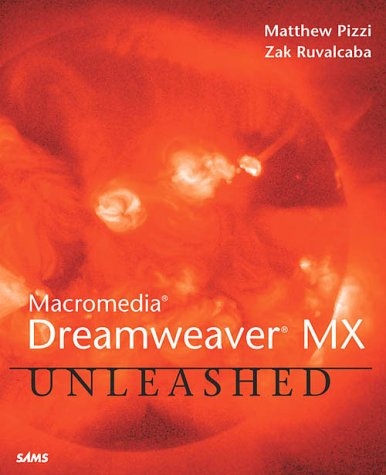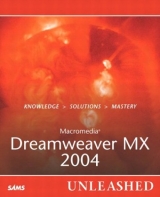
Macromedia Dreamweaver MX Unleashed
Sams Publishing (Verlag)
978-0-672-32446-8 (ISBN)
- Titel erscheint in neuer Auflage
- Artikel merken
PLEASE PROVIDE
Macromedia Dreamweaver MX Unleashed is the first complete reference guide to cover Dreamweaver MX's new and powerful features that aid in server-side programming, as well as strategies for designing, managing and developing sophisticated Web sites.
A reference for advanced users on complex application development techniques, this book guides developers into the realm of dynamic sites enabling a richer experience for the end user.
Developers learn how to collect information from a user and personalize their Web experience and how to use Dreamweaver MX management tools that aren't thoroughly covered in other intermediate-level Dreamweaver books.
Matthew Pizzi is the Training Director at Train Simple (www.trainsimple.com), a software training company specializing in multimedia products, located in Santa Monica, California. Matthew has been teaching Macromedia products for several years and is the author of Flash MX Unleashed by Sams Publishing. He has also authored multiple training CDs. Matthew now heads up Train Simple online training efforts with their revolutionary Web-based training system. Train Simple offers a robust training experience by means of qualified instructors, and top-quality curriculum delivered though small, intensive workshops. As a Macromedia Certified training provider, a Quark Certified Training Center, Discreet Authorized Training Center, as well as an Apple Authorized Training Center, Train Simple offers the most complete, up-to-date software training for all levels. Training levels range from the private enthusiast to the multimedia professional. For more information on classes, or training CDs, please visit www.trainsimple.com. Zak Ruvalcaba has been researching, designing, and developing for the Web since 1995. He holds a Bachelor's Degree from San Diego State University and a Master of Science in Instructional Technology from National University in San Diego. He served as Creative Director with EPIC Solutions until 1998. His expertise in developing Web applications led him to a position as Manager of Web Development at SkyDesk, Inc., where he developed Web solutions for such companies as Gateway, HP, Toshiba, IBM, Intuit, Peachtree, Dell, Covad Communications, and Microsoft. He has worked at ADCS Inc. and Wireless Knowledge as a software engineer, developing .NET solutions for Mellon Financial, Goldman Saks, TV Guide, Healthbanks, The Gartner Group, and Commerce One. His skill set includes technologies and languages from HTML, XHTML, XML/XSLT, WML, ASP, ASP.NET, Visual Basic.NET, Web Services, JavaScript, CSS, SQL, and ActionScript. Utilizing these technologies he is the founder and president of Module Media, a new media development and training firm in San Diego. Aside from teaching and holding design lectures on various technologies and tools, including Dreamweaver MX, Flash MX, and ASP.NET for the San Diego Community College District, Zak Ruvalcaba is the author of the 10 Minute Guide to Dreamweaver 4 by Que Publishing, and is a Macromedia Certified Professional.
Introduction.
I. GETTING UP TO SPEED WITH DREAMWEAVER MX.
1. What's New in Dreamweaver MX.
New Interface Enhancements. Dreamweaver Workflow Enhancements. Enhanced CSS Styles. Accessibility. Dreamweaver MX Offers Rapid Application Development.
2. Welcome to the Dreamweaver MX Interface.
Panels and Inspectors. Document Window. Document Size and Web Page Dimension.
3. Dreamweaver MX Site Management.
Setting Up a Web Site in Dreamweaver MX. Managing a Web Site in Dreamweaver MX. Working with the Site Window/Panel. Synchronizing Local and Remote Files. Working with the Site Map. Changing Links. Checking Links. Using Site Reports. Checking Browser Compatibility.
4. Dreamweaver MX Essentials.
Working with Dreamweaver MX. Working with an HTML Document. Working in the Coding Environment. Web Typography. Creating Lists. HTML Styles. Inserting the Time and Date. Inserting a Horizontal Rule. Working with Hyperlinks. Email Links. Named Anchors. Images on the Web. Inserting Images into a Dreamweaver Document. Image Maps. Rollover Images. Navigation Bars. Background Images. Image Placeholders.
II. STATIC WEB PAGE CREATION.
5. Creating Tables.
Using Tables in Dreamweaver MX. Table Terminology. Inserting and Working with Tables. Modifying Tables. Modifying Table Properties. Working with Table Borders. Adding and Deleting Rows and Columns. Resizing Tables. Working with Table Formats. Sorting Tables. Importing Tabular Data. Layout View. Drawing Cells. Tracing Images.
6. HTML Forms.
Inserting a Form in Dreamweaver MX. Inserting Form Objects. Real World Forms, Building Forms That Work. Hidden Field. Setting Focus in a Form.
7. Framesets.
Understanding Frames. Creating Framesets and Frames. Saving Framesets. Modifying and Resizing Frames. Adjusting Frame Attributes. Changing Page Properties. Saving, Closing, and Opening a Frame. No Frames Content. iFrames.
8. Dreamweaver Templates.
Templates or Framesets? More About Templates. Creating a Template. Optional Regions. Nested Templates. Updating Template-Based Pages.
9. Assets and the Library.
Working with the Assets Panel. Working with Library Items.
10. Cascading Style Sheets.
A Brief Introduction to Styles. Designing with CSS. Style Properties. Working with CSS Styles. Editing CSS in Code View.
11. Layers in Dreamweaver.
Introduction to Layers. Creating Layers. Deleting a Layer. Embedding a Layer with Style Sheets. Inserting Content into Layers. Sizing, Positioning, and Modifying Layers with the Properties. Inspector. Modifying Layer Properties with the Layers Panel. Designing a Page with Layers.
III. ADDING INTERACTIVITY.
12. DHTML.
Animation with the Timeline. Adding Layers to the Timeline. Triggering Behaviors from the Timeline. Creating a Slide Show by Changing the Image's Source.
13. Adding Video and Audio.
Media Players. Adding Video to Your Pages. Embedding Video Clips. Linking Video. Embedding Video with the Tag. Adding Audio to a Web Page.
14. Inserting Flash and Shockwave.
Creating Flash Buttons in Dreamweaver MX. Creating Flash Text in Dreamweaver MX. Inserting Flash Files. RoundTrip Flash Editing. Inserting Shockwave into a Dreamweaver Document. Controlling Shockwave and Flash Movies with Behaviors.
15. Integration with Complementing Programs.
Specifying External Editors. Editing Images in Dreamweaver with Fireworks. Optimizing an Image in Dreamweaver with Fireworks. Inserting Fireworks's HTML Command. Creating a Web Photo Album. Using Photoshop with Dreamweaver MX.
III. INTRODUCTION TO WEB APPLICATIONS.
16. Introduction to Web Applications.
Terminology. Middleware Options. Database Options.
17. Web Application Preparation.
Introduction. Setting Up the Web Server. Setting Up the Application Server. Database Connectivity.
18. Dreamweaver MX for Application Development.
Create a Connection with a Data Source Name. Custom Connection Strings.
V. BEHAVIORS AND MIDDLEWARE.
19. Behaviors.
Attaching Behaviors. Calling JavaScript. Change Property. Check Browser. Check Plug-In. Drag Layer. Go to URL. Jump Menu. Play Sound. Pop-Up Message. Preload Images. Set Nav Bar Image. Set Text. Show-Hide Layers. Show Pop-Out Menu. Swap Image/Swap Image Restore. Validate Form.
20. Extending Dreamweaver MX.
Working with Objects. Working with Behaviors. Customizing Dreamweaver MX Menus Using menus.xml. Sharing Extensions.
21. Working with CGI and Java Applets.
Server-Side Programming. Client-Side Versus Server-Side Programming. Beyond CGI. How CGI Works. Perl. Java.
22. ASP and ASP.NET.
Introduction to ASP. Introduction to ASP.NET. Beyond Dreamweaver MX.
23. JSP.
Introduction. JSP in Dreamweaver MX. Beyond Dreamweaver.
24. PHP and MySQL.
Basic PHP. Advanced PHP. Working with Dreamweaver MX for PHP Development.
25. Looking Ahead.
Forging Ahead.
VI. DATABASE-DRIVEN PAGES.
26. Database Primer.
What Is a Database? The Database Management System (DBMS). The Database. Beyond the Basics. Designing the Web Store Database. Creating Relationships between the Tables.
27. SQL Primer.
The Structured Query Language. Basic SQL. Expression. Operators. Functions. Clauses. Joins. Subqueries. Using Access to Generate Queries.
28. Working with Dynamic Data.
Building the Web Store Application Using ASP. Creating the View Catalog Page. Building the Web Store Application Using ASP.NET. Creating the View Catalog Page. Live Data Mode.
29. Modifying the Database.
Creating the Web Store New User Registration Page Using ASP. Creating the My Account Page Using ASP. Building the Web Store New User Registration Page Using ASP.NET. Creating the My Account Page Using ASP.NET. Using Application Objects to Create an Admin Page.
31. SQL Search Page.
SQL Search.
31. Adding Shopping Cart Functionality.
Creating the Web Store Shopping Cart.
32. Security and User Authentication.
Securing the Web Store. Securing ASP.NET Applications.
VII. APPENDIXES.
Appendix A: Accessibility.
Accessibility Standards. Accessibility Reference. Summary.
Appendix B: Server Behavior Builder.
Downloading Extensions. Hand Coding Your Own Server Behavior. Server Behaviors. Summary.
Appendix C: Integration with Flash MX.
Writing ActionScript with Dreamweaver MX. Integration with Middleware. Previous Integration Methods. Macromedia Flash Remoting Service. Summary.
Appendix D: Language Resources.
Links. Database Conversion. Troubleshooting Dreamweaver MX Application Development Errors. Web Service Proxy Class Issues.
Appendix E: ColdFusion MX Tags and Beyond.
Introduction to ColdFusion. How to Get ColdFusion. Introduction to ColdFusion Markup Language. Using Dreamweaver to Write CFML. Tag Chooser. Include Pages with ColdFusion. Hand Coding ColdFusion. Code Snippets. Summary.
Index.
| Erscheint lt. Verlag | 24.12.2002 |
|---|---|
| Verlagsort | Indianapolis |
| Sprache | englisch |
| Maße | 188 x 231 mm |
| Gewicht | 1671 g |
| Themenwelt | Mathematik / Informatik ► Informatik ► Grafik / Design |
| Mathematik / Informatik ► Informatik ► Web / Internet | |
| ISBN-10 | 0-672-32446-6 / 0672324466 |
| ISBN-13 | 978-0-672-32446-8 / 9780672324468 |
| Zustand | Neuware |
| Haben Sie eine Frage zum Produkt? |
aus dem Bereich



